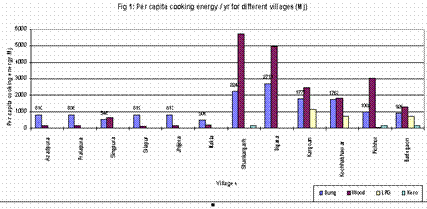|
Domestic Energy in
the Bundelkhand Household
Rajesh Bajpai T he Bundelkhand region of North India is characterised by a depleted resource base, energy crisis and low productivity of land; all of which lead to rampant loss of livelihood opportunities. Energy, therefore, plays a crucial role in the economy of this region. The fuel mix here is characterised by a dominance of bio-fuels, including wood and non-wood biomass, agro-residues and to a large extent cow dung. Only 12- 13 per cent households use commercial forms of fuel, while 50 per cent use wood and other woody biomass and about 37 per cent use cow dung.A few representative villages of this region in the Niwari block of Tikamgarh (MP) and Badegaon block of Jhansi (UP) have been selected and the highlights of some of the analysis presented below.
A study of fuel types shows that there is overall a good diversity in fuel usage. Although there is a distribution in the fuel usage pattern, biomass continues to have a large share in the total domestic energy. In this region, mainly in rural areas, existing fuel for cooking purposes can be categorised as ‘Mono’, ‘di’, and ‘multi’ usage of material. ‘Mono’ material usage is a single type of fuel which is usually either dung or wood or kerosene. Di-material usage is the use of a combination of two types of fuels, usually dung - wood, dung - kerosene or wood - kerosene. Multi-material usage would include three-four types of fuel viz., dung-wood-kerosene or dung- wood- kerosene- LPG. The distribution of three different categories of fuel usage in the representative villages of Bundelkhand indicates that di-material usage of fuel (dung - wood ) is common in every village. Trimaterial usage of fuel is high in Kochhabhawar (dung-wood-LPG) because of existence of more diversity of livelihood activities compared to other villages.
Further the energy utilisation and fuel use are also directly linked with the issues of livelihood and so interventions for the livelihood technology like brick kilns, pottery etc. for effective fuel use is also crucial. q The
author is an Engineer with the
Back to Contents |
 While
diversity of fuel usage is an extremely important parameter, as it
defines the susceptibility of that particular fuel type, the per
capita cooking energy requirement is equally important. This factor
defines the life-style of the people in this region. It is
interesting to note that the ratio of non-commercial: commercial
fuel types, which is 3 : 1 in these villages, is very high. The
figure below shows the per capita cooking energy in the region. The
per capita cooking energy consumption of wood is high in Shankargarh
where more wasteland is available and where there is no any other
resource for cooking. Per capita cooking energy consumption of dung
is high in village Digara because of high availability of livestock
and with the main livelihood activity as dairying. Digara also
supplies dung as a fuel to other villages for purposes of cooking,
potteries, brick kilns etc. LPG commercial fuel is used only in
three villages viz, Karguva, Pichor and Badegaon because these
villages are very close to Jhansi city. Increased options and fuels
with improved performance are urgently required. Improving the
efficiency of resource use through appropriate solutions will not
only reduce degradation of forest land but also stop the diversion
of cow dung as a fuel instead of it being used as manure.
While
diversity of fuel usage is an extremely important parameter, as it
defines the susceptibility of that particular fuel type, the per
capita cooking energy requirement is equally important. This factor
defines the life-style of the people in this region. It is
interesting to note that the ratio of non-commercial: commercial
fuel types, which is 3 : 1 in these villages, is very high. The
figure below shows the per capita cooking energy in the region. The
per capita cooking energy consumption of wood is high in Shankargarh
where more wasteland is available and where there is no any other
resource for cooking. Per capita cooking energy consumption of dung
is high in village Digara because of high availability of livestock
and with the main livelihood activity as dairying. Digara also
supplies dung as a fuel to other villages for purposes of cooking,
potteries, brick kilns etc. LPG commercial fuel is used only in
three villages viz, Karguva, Pichor and Badegaon because these
villages are very close to Jhansi city. Increased options and fuels
with improved performance are urgently required. Improving the
efficiency of resource use through appropriate solutions will not
only reduce degradation of forest land but also stop the diversion
of cow dung as a fuel instead of it being used as manure.